Here you are going to find out more about YAQUI Cycles as a company, people behind it, production and other "inside" details what make us different from the others.
Click on the image for bigger picture
Who are we and what is our purpose in The Universe?
Probably you asked yourself this question a million times (I know I have), so let me tell you about Yaqui Cycles.
I'll start from the second part of the question - We were probably sent by Common Sense Forces to help Humanity to overcome the dark forces of False Advertising and Commercial Lies.
We do realize that too much honesty and straight forward attitude, might not always help our sales, BUT our philosophy is that there is obviously enough people who use their common sense and are willing to understand and accept the reality, and by doing that - they keep our company in a good shape, financially.
"What does the YAQUI name stand for?"
Well, that's kind of complicated, because that's the name of a North American Indian tribe, but we have no connections with Yaqui Indian tribe or any native Indian issues at all.
So why Yaqui?
The story starts like this: "Some time in September 1999, we were riding our bikes on the roads of Southern California, better known as
Anza Borego National Park.
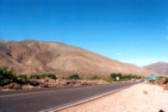
A hot day, hot and dry air, but even worse - hills, hills and hills all over. My good friend Dan Empfield and I... now wait a minute here, isn't that the same Empfield, Mr. QRMan, Mr. 650C, Mr. Tri and presently Mr.SlowMan@slowtwitch.com ? Yes, that's right. I didn't say Ex. Mr. QRMan (as some cynics like to call him) - simply because for those of us, who are in this sport with our hearts and passion - there is only one QRMan. Now and forever. The fact that Mr. Empfield is not any more the leader of the company which once was the most influential in TriSport, doesn't change the fact of who he is. His vigor, ideas and passion will stay forever connected with the name of Quintana Roo - no matter who owns the company at the moment. Nobody can change or deny the fact that Daniel Empfield is one of the most respectful characters of TriSport. Both Dan and I have years of positive cooperation, and nevertheless, we have a passion for turning the pedals.
Let's roll it back again- it's the September of 1999, we are riding on
 HWY-78, crossed already over Borrego Springs Rd. and Montezuma Valley
Rd. (For those of you, not familiar with these exotically named roads of
Southern California, - don't imagine paradise, palm trees, tropical flowers,
birds and water streams! Nothing like that.
HWY-78, crossed already over Borrego Springs Rd. and Montezuma Valley
Rd. (For those of you, not familiar with these exotically named roads of
Southern California, - don't imagine paradise, palm trees, tropical flowers,
birds and water streams! Nothing like that. 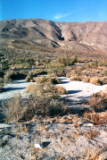 This is actually a desert. Empty spaces, no shade,
rocky-stripped hill sides. But the roads... !!! You can compare them with any Italian "Passo" or French "Col".
Beautiful roads rolling over hills - and no
This is actually a desert. Empty spaces, no shade,
rocky-stripped hill sides. But the roads... !!! You can compare them with any Italian "Passo" or French "Col".
Beautiful roads rolling over hills - and no cars around!
cars around! So we are heading to Banner (population of 9.5 people; 3.34 chickens and maybe 1 egg!). We logged about 6000Ft of climbing already, and we are going for 5,000Ft more. Dan is squeezing us "on the rivets" and I am in shock, tired and exhausted. I've never been good on the hills, but for some strange reason I like them - and I just hate flats! So we are talking about cycling, sport and how I wouldn't want to call my line of Tri bikes the same as my Road bikes - "MANDARIC" when he says: "Here, there is the name for your Tri bikes" - pointing to the street sign saying "Yaqui Pass Rd." At that point,
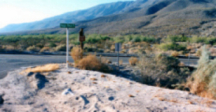 I was already so exhausted, I could only think of "Who the
hell would call the frame "YAQUI PASS ROAD" imagining a long decal on the
frame's down tube! So I told him that - and he replied - "No, not the whole
thing, not the pass and the road, only Yaqui - call it YAQUI!"
I was already so exhausted, I could only think of "Who the
hell would call the frame "YAQUI PASS ROAD" imagining a long decal on the
frame's down tube! So I told him that - and he replied - "No, not the whole
thing, not the pass and the road, only Yaqui - call it YAQUI!"Now you know - it's really simple. Our name comes from the name of the road, at the far South of California.
Back to TOPFirst
Who invented it first?
Ves Mandaric, born in April of 1956 in former Yugoslavia. Started MANDARIC Bicycles Co. 25 years ago - in 1976.
Plenty of research and work on finding better solutions for the frame geometry resulted in design of a frame with revolutionary new geometry. In 1981 I submitted a
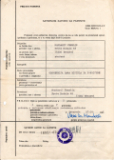
Patent Pending Application - for the "Geometry of Racing Bicycle Frame" - later known as "Upright seat tube geometry".
I got the idea about tilting the Seat Tube forward from one simple reason - a pain in the ass from 2+ Hours of hectic pedaling at the 1979 100Km National Team Time Trial Championship: the last 15Km I set on the very peak of the saddle trying to pedal as fast as I could. The result?
The team was in the first 5, but my "rear" was in pain.
My idea about the better geometry was to
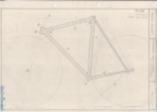 move forward (rotate) the Seat Tube along with the Handlebar
position, around the Bottom Bracket, while maintaining the same proportion of
those three parameters (BB/Saddle/Handlebar) - as on the road bike. That way
the rider is allowed to use muscles more efficiantly, breath easier, and get
into a more aero position. The idea was to move the seat tube forward as much
as possible and thus the rear wheel towards the seat tube for more compact bike
(not to be confused with recently introduced term for the road frame geometry).
Anybody who studied "Dynamic movement of the point" and "Dynamics of single
line vehicles", (for those who don't know, these courses are the two
fundamentals on Technical/Mechanical Studies) knows that the bike, as a single
line vehicle, have smaller rolling resistance if the wheel base is shorter,
which means, with the same energy applied - the bike would move faster. In an
extreme case, such as a unicycle, where there is no drag from the front wheel,
and there is maximum possible transfer of the force from the wheel to the
ground. I am not talking about air-drag, but about friction from the road: - as
the front wheel is wasting energy being "dragged" on the road, opposite to the
rear wheel which is "driving" or force-transferring wheel. Of course, with
shortening of the wheel base, system's stability is effected, so taking that in
consideration, there are limits to how much you can shorten the wheel base. A
extreme exhample is again, the unicycle - try to do some switchbacks on it, at
40mph!!!
move forward (rotate) the Seat Tube along with the Handlebar
position, around the Bottom Bracket, while maintaining the same proportion of
those three parameters (BB/Saddle/Handlebar) - as on the road bike. That way
the rider is allowed to use muscles more efficiantly, breath easier, and get
into a more aero position. The idea was to move the seat tube forward as much
as possible and thus the rear wheel towards the seat tube for more compact bike
(not to be confused with recently introduced term for the road frame geometry).
Anybody who studied "Dynamic movement of the point" and "Dynamics of single
line vehicles", (for those who don't know, these courses are the two
fundamentals on Technical/Mechanical Studies) knows that the bike, as a single
line vehicle, have smaller rolling resistance if the wheel base is shorter,
which means, with the same energy applied - the bike would move faster. In an
extreme case, such as a unicycle, where there is no drag from the front wheel,
and there is maximum possible transfer of the force from the wheel to the
ground. I am not talking about air-drag, but about friction from the road: - as
the front wheel is wasting energy being "dragged" on the road, opposite to the
rear wheel which is "driving" or force-transferring wheel. Of course, with
shortening of the wheel base, system's stability is effected, so taking that in
consideration, there are limits to how much you can shorten the wheel base. A
extreme exhample is again, the unicycle - try to do some switchbacks on it, at
40mph!!!I built first few frames with 85Deg seat angle. The bikes were fast, very fast. One of those bikes was reviewed by a local magazine, and some of the very good Yugoslavian riders were riding it with great results. Unfortunately, the whole thing appeared to be "too good to be truth" - my Patent Pending Demand was rejected by the Yugoslavian Patent Bureau, with a bunch of bureaucratic phrases in the explanation, (something to do with the production in a socialistic country) - somehow I gave up on the whole project.
Upright seat tube geometry present in Triathlon is a little "softer" in angle, but the idea is the same.
So whenever you see a bike with an upright seat tube, just remember: Ves Mandaric is the first who envisioned and developed such a geometry - all the way back in 1981!
And I can say that I am sincerely happy seeing that my idea has had such a big impact on the sport of Triathlon, even though I am not "officially" recognized as an inventor. (Being born in the "wrong" country didn't exactly help my project.)
Back to TOPFirst